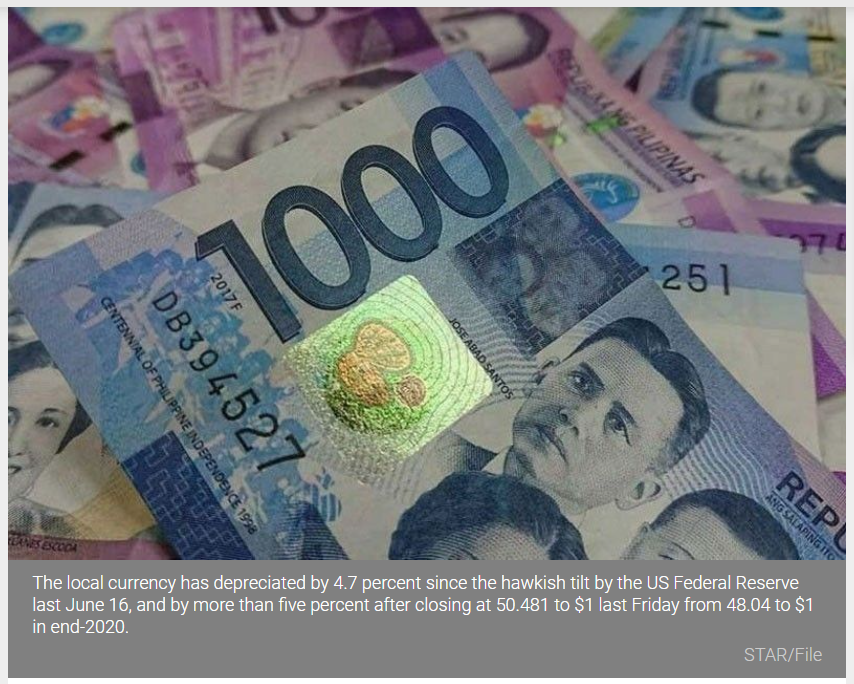Philippines: Peso weakness seen to boost exports
MANILA, Philippines — The Bangko Sentral ng Pilipinas (BSP) may tolerate the weakening of the peso against the dollar to boost the competitiveness of exporters as the country continues to struggle to curb the spread of COVID-19, according to Fitch Solutions Country Risk & Industry Research.
The local currency has depreciated by 4.7 percent since the hawkish tilt by the US Federal Reserve last June 16, and by more than five percent after closing at 50.481 to $1 last Friday from 48.04 to $1 in end-2020.
Fitch Solutions said the peso remains overvalued on a real effective exchange rate basis.
“The peso had been broadly stable against the dollar through the pandemic, while other emerging market currencies have sold off, but rising investor expectations for an earlier-than-expected Fed tapering and the Philippines’ persistent bouts of COVID-19 outbreaks have weighed on appetite for peso-denominated assets. As such, we believe the Peso… From B1
BSP will tolerate some peso depreciation to bolster the country’s export competitiveness,” it said.
The research arm of the Fitch Group pointed out the BSP could limit currency volatility if needed in the coming quarters due to its ample foreign exchange reserve position.
Latest data from the central bank showed that the country’s gross international reserves (GIR) increased slightly to $106.55 billion in July from $105.76 billion in June due to higher inflows arising from more foreign borrowings to finance the government’s COVID-19 response measures as well as higher prices of gold in the world market.
“We expect the BSP to shrug off any market concerns surrounding the depreciation of the peso in recent weeks, as it has done with the temporary overshoot of headline inflation through H121,” Fitch Solutions said.
Fitch expects inflation to average four percent this year after cooling over the second half from the 4.4 percent average in the first half. This would prompt the Monetary Board to keep interest rates at record lows until the second half of next year before hiking by 50 basis points by the end of 2022.
“We maintain our forecast for the BSP to remain on hold until second half of next year, when we expect the economy to show signs of a sustained recovery with credit growth returning to trend levels. As the Philippines faces another wave of new cases, we believe the BSP will keep monetary conditions on hold to provide accommodative monetary conditions to support the domestic economy through the pandemic disruptions,” it said.
Fitch Solutions said the need for further policy rate cuts appears muted, given the existing weak demand for credit, as bank lending contracted by 0.4 percent led by the 8.7 percent drop in consumer lending.
As the National Capital Region and nearby provinces were placed under enhanced community quarantine from Aug. 6 to 20 to slow the spread of the more contagious COVID-19 variant, it said it would closely watch the pace of the vaccination program as well as how the current wave of new cases affect the country’s economic recovery.
“A spread of the Delta variant to other regions and prolonged nationwide lockdowns could even prompt the BSP to ease monetary conditions further to support growth. For now, we think any monetary easing would come via the lowering of reserve requirement ratios rather than a cut to the key policy rate,” Fitch Solutions said.
BSP Governor Benjamin Diokno earlier reiterated the central bank remains committed to a flexible exchange rate system and would continue to rely on a set of measures to cushion the impact of sharp peso movements such as maintaining a healthy level of foreign exchange reserves as a buffer, reviewing and calibrating existing macro-prudential measures.
The peso is not the lone currency to depreciate against dollar as the peso-dollar trend continues to be broadly in line with regional peers. Most regional currencies have similarly depreciated against the dollar, as these currencies have been weighed down by prospects of earlier US monetary policy normalization and uncertainties in their growth outlook due to the ongoing health crisis.
“While short-run fluctuations in the peso are affected by market sentiment, its medium- to long-term movements are largely supported by economic fundamentals as indicated by the relative stability in the movement of the real effective exchange rate of the peso,” Diokno said.
Source: https://www.philstar.com/business/2021/08/16/2120185/peso-weakness-seen-boost-exports


 English
English




